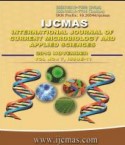


 National Academy of Agricultural Sciences (NAAS)
National Academy of Agricultural Sciences (NAAS)

|
PRINT ISSN : 2319-7692
Online ISSN : 2319-7706 Issues : 12 per year Publisher : Excellent Publishers Email : editorijcmas@gmail.com / submit@ijcmas.com Editor-in-chief: Dr.M.Prakash Index Copernicus ICV 2018: 95.39 NAAS RATING 2020: 5.38 |
Eight parental lines including one gynoecious line PDMGy-201 (Gy-23) and their 28 F1 hybrids obtained from half diallel analysis were used to estimate the extent of heterosis for earliness, yield and its contributing traits in bitter gourd. The F1 hybrids developed using gynoecious line as one parents were found to be superior in performance over mid and standard parents for several earliness and yield characters. The best F1 hybrid for earliness and desired sex ratio was PDMGy-201 × S-2 which recorded -32.58% heterosis for days to opening of first female flower over mid parent and -35.96% over standard parent. This hybrid also showed -23.65% heterosis for days to first picking over mid parent and -28.24% over standard parent. The hybrid PDMGy-201 × S-2 showed -95.93% and -69.83% heterosis for sex ratio (male: female) over mid and standard parent respectively. The monoecious hybrid, S-54 × S-57 showed higher heterosis for fruit length (33.43%) over mid parent, for fruit diameter (15.12%) over standard parent and for flesh thickness (54.88 %) and (29.07%) over mid and standard parent respectively. All the 28 F1 crosses exhibited significant desirable heterosis for average fruit weight and yield per plant over mid and standard parent. The best performing F1 hybrid PDMGy-201 × PV recorded 67.5% and 67.22% higher yield over mid and standard parent and 18.92% increase in number of fruits per plant over standard parent which may be exploited for commercial cultivation.
 |
 |
 |
 |
 |